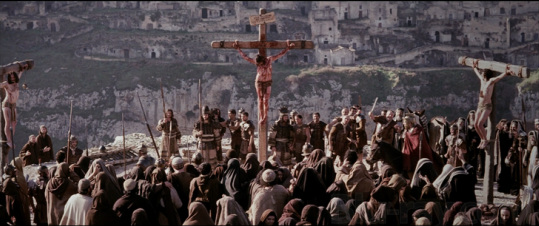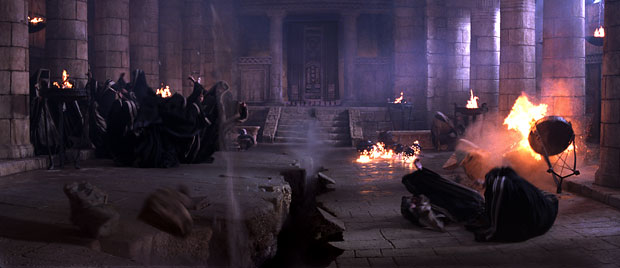|
Good Friday, THE day of consummation, began early with a trial with Annas, a Jewish trial at Caiphus house (where Peter denied Christ), a trial in the temple with the Sanhedrin (when Judas hung himself), a Roman trial with Pilate, a Galilean trial with Herod Antipas, & final trial with Pilate again as he tried to avoid crucifying Christ via flogging, scourging, and releasing Barabbas. Once convicted for sedition (misinterpreting Christ's kingly claims), Christ was mocked by Roman Soldiers with a crown of thorns, then stripped and beaten. Christ was then led to Golgotha carrying His own cross (until Simon of Cyrene had to intervene), where He was nailed to the cross, which was erected between two criminals and bore the message “This is Jesus of Nazareth, the King of the Jews.” The soldiers, Pharisees, & crowds derided Christ, but He prayed for their forgiveness. When the thief repented Christ promised him paradise. Christ then assigned his familial responsibilities to John. At noon when darkness covered the land Christ lamented separation from God as He took on God's wrath. Christ then fulfilled Psalm 69:21 saying “I thirst.” Christ died after two final words: “It is finished,” & “Father, into your hands I commit my spirit” as Jesus voluntarily died at the completion of His mission. At His death there was an earthquake in which the temple curtain was torn and saints were resurrected and appeared to many, resulting in the belief of many including the Roman Centurion. His body pierced to confirm death, Jesus's body was laid in a tomb covered with a stone and guarded by Roman soldiers. 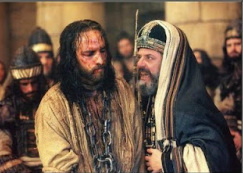 The Passion of the Christ. © Icon Productions The Jewish Trials Trial at Annas' house - Good Friday began early with several trials with the Jews. The first was an informal trial at Annas' house (a Jewish elder) to seek advice and authority on how to proceed under both Jewish and Roman law. This would have included an analysis Pilate's political state. Trial at Caiphus' house - Jesus was then brought to the house of Caiphus the High Priest. There they held a Jewish Trial to establish blasphemy charges, but they did not have a full quorum of the Sanhedrin. Jesus is interrogated and false witnesses are brought to testify, but the stories do not line up. Jesus remains silent through the whole proceeding until Caiaphas asks Jesus if He is the Messiah, to which Jesus answers affirmatively saying "You have said so" and then applies Daniel to Himself that the Son of Man will come with authority in clouds. At this the leaders tear their robes saying He has blasphemed. They mock Jesus, asking Him to prophesy who hit Him as they strike Him. Peter, having gained access to the home via John, denies Jesus 3 times and Jesus looked at Peter on the third time when the Rooster crowed. Trial at Temple – The trial is then moved to the temple with the full Sanhedrin to determine how to proceed to with Roman charges from the Jewish blasphemy charge. Their logic: Messiah = King and King = Sedition. Judas returns the money out of remorse, but the callous leaders don't care and proceed anyway. Judas then commits suicide via hanging. The Jews use the returned money to by the "Field of Blood" since it is blood money and cannot be put into the Temple treasuries. 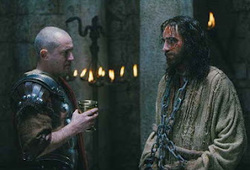 The Passion of the Christ. © Icon Productions The Roman Trial with Pilate: Phase 1 Outside - Pilate comes out to the Praetorium steps to hear the charges against Jesus of sedition for claiming to be a king. Pilate tries to deny the charges, unsuccessfully, largely aided by his wife's unsettling dream. Inside - Pilate brings Jesus inside the Praetorium to interview him where he asks "are you a king?" Jesus tells him "it is as you say" and "my kingdom is not of this world," or else His people would fight to free Him. "You are a king then," Pilate concludes, and Jesus states that everyone on the side of Truth is for Him, but Pilate scoffs asking "what is Truth?" Outside - Pilate comes back out on the Praetorium steps and Jesus is accused by his prosecutors, but remains silent, which amazes Pilate. Pilate then declares that Jesus is innocent (1st time). However, the religious leaders and the mob are dissatisfied and claim that Jesus has been stirring up trouble all the way from Galilee and has now come here. Learning that Jesus is a Galilean Pilate tries to shirk responsibility for condemning an innocent man and sends Jesus to the tetrarch Herod. 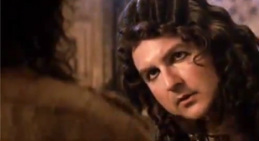 The Passion of the Christ. © Icon Productions The Palestinian Trial with Herod Herod, the local governor of Palestine appointed by Rome, has wanted to see Jesus for some time, but primarily to see Jesus perform miracles. Jesus is accused by the Jews, but Jesus remains silent and refuses to entertain Herod. Thus, Herod and his court mock Jesus by parading him around as a king. However, Herod is no fool and knowing the political gravity of the situation sends Jesus back to Pilate. Probably sympathetic to the mess they're both in, Herod and Pilate become friends after this. 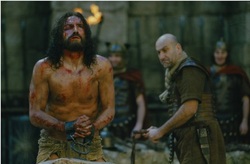 The Passion of the Christ. © Icon Productions The Roman Trial with Pilate: Phase 2 Jesus is brought back to Pilate at the Praetorium. Inside - The Sanhedrin is summoned inside away from the crowd where Pilate tells them that Jesus is innocent of the capital crime of sedition. The Sanhedrin regroups and remind Pilate of the tradition of Clemency (annually at Passover the governor released one criminal that the people requested). Pilate has Jesus chastised in hopes of pacifying them, sensing that his real crime was claiming to the "Son of God." Outside - Pilate takes Jesus outside to the crowd declaring Jesus innocent and saying "Behold the man!," but the crowd, manipulated by the Jews, wants Jesus crucified. Pilate then makes a strategic blunder asking them if they want him to release Jesus, who he assumed they were merely jealous of, or Barabbus a known thief and murder. The crowd demands Barabbus. Pilate asks them what he should do with Jesus, to which they demand "Crucify him!" Pilate again testifies to Christ's innocence asking "Why, what crime has he committed?" Pilate caves to the crowd as Jews pressured him: “If you let this man go, you are no friend of Caesar” Pilate has Jesus scouraged, soldiers put crown of thorns, purple robe, and scepter on Him. They mock him and beat Him with the scepter. Inside - Pilate's superstitious fears cause him to interview Jesus again, asking "where are you from?" Jesus remains silent to Pilate's amazement since he has the power to set Jesus free and Jesus recognizes a higher power than Rome. 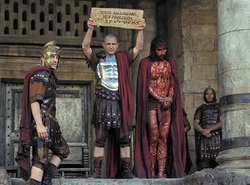 The Passion of the Christ. © Icon Productions Outside - Pilate takes Jesus outside saying "Behold your king!," but the crowd claims they have no King but Ceasar and to crucify Jesus. Pilate declares Jesus innocent for the 4th or 5th time, washing his hands of His blood and the crowd accepts the blood on their heads and their children's heads. Inside - Pilate turns Jesus over for crucifixion. Further flogging would prepare Jesus for crucifixion. 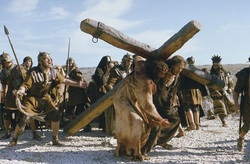 The Passion of the Christ. © Icon Productions The Road to Golgotha (via dolorosa) Jesus is forced to carry His own cross (at least the top cross beam), until He proves too weak from the scourging and Simon of Cyrene is conscripted to intervene. Jesus speaks words to the women of His entourage along the journey. Jesus refuses wine/myrh mixture either as a painkiller or pain increaser offered to him. 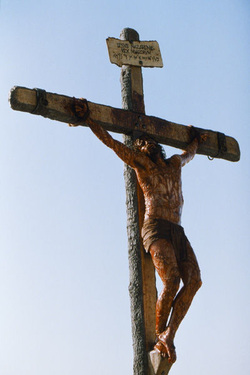 The Passion of the Christ. © Icon Productions The Crucifixion Golgotha - Jesus is nailed to the cross, which is erected between two criminals. Pilate has a sign attached to Christ's cross which read: This is Jesus of Nazareth, The King of the Jews. Thew Jews complain wanting Pilate to add to the sign Jesus "claimed to be," but Pilate shows some backbone and refuses to change it. First 3 Hours - Christ is derided by crowds passing, derided by religious leaders, derided by thieves, and derided soldiers dividing His garments by lot (fulfilling Psalm 22:18 prophecy). Jesus First Word from the cross is to ask the Father to forgive them for they know not what they do. One thief then defends Jesus from his former comrade, repents and recognizes Jesus' innocence and heavenly Kingship. asking Him to remember him when he comes into His kingdom. Jesus Second Word from the cross is to assure the thief that he will be with Him today in Paradise. The people at the cross included: Jesus mother Mary, His aunt Salome, Mary Magdalene, Mary wife of Clopas and the only disciple John. Jesus Third Word from the cross is to ensure His mother is taken care of by assigning Her to John's care. Last 3 Hours - Darkness comes at Noon. Jesus Fourth Word from the cross is lamenting "My God My God Why have you forsaken me?" as the sins of the world were poured out on Him to satisfy the wrath of God, an act which temporarily separated Him from the Trinity. However, it is through this act that Christ was able to act as our vicarious substitutionary atonement. The crowds confuse "Eloi" for "Elijah" and wonder if Jesus is calling the prophet. Jesus Fifth Word from the cross is "I Thirst" to fulfill the prophecy in Psalm 69:21 (and may carry a spiritual significance in light of taking all the sins of the world). A sponge of wine vinegar is offered to Him on a pole. Jesus Sixth Word from the cross is "tetelestai" or "it is finished" marking the completion of His mission to pay the penalty for all sin so that mankind might be redeemed and be able to have a restored relationship with God. Jesus Seventh Word from the cross is "Father, into your hands I commit my spirit" which shows Jesus voluntarily giving up His own life into the care of the very Father who had just forsaken Him. Then Jesus died. Post Death When Jesus died an earthquake struck. The curtain in the Temple shielding us from the Holy of Holies (the most holy place) tore from top to bottom signifying our new access to God directly through Jesus Christ. Tombs break open and people are resurrected, witnessing to people. Many believe including the Centurion, who is convinced of Christs' innocence by the way He died. Jesus is pierced to confirm death, but the other criminals have their legs broken since the calloused Jews don't want bodies up on the Passover. Pilate is shocked Jesus died so fast. 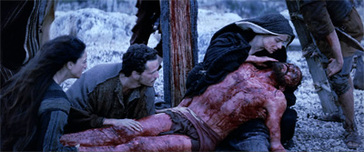 The Passion of the Christ. © Icon Productions Jesus' Burial Jesus's body is prepared by Joseph Arimethea and the Pharisee Nicodemus and then laid in a new tomb with a rolling stone entrance. Pilate confirmed the death and posted Roman soldiers to the tomb, as requested by the Jews, to keep the disciples from stealing the body, for they remembered that Jesus claimed he would rise. The woman learn of of the Tomb's location.
0 Comments
Leave a Reply. |
AuthorBrett Yardley: Categories
All
Archives
January 2019
|
